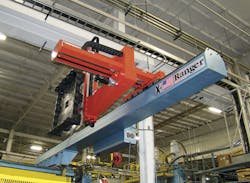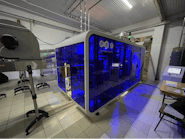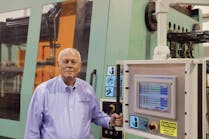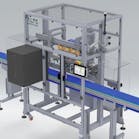This class of robots, also known as linear or gantry, has found its way into many molding operations. Compared to six-axis robots, three-axis robots are simpler to operate because generally their axes move in a linear motion.
Suppliers involved in the production of Cartesians have announced new products or upgrades to existing products along with projects where robots may not have had much of presence previously.
ROBOTS TAKE ON STRUCTUAL FOAM
Structural foam molding presents unusual challenges for automation. Think about the large parts that are produced by these machines, like pallets and pool slides or roofs for sheds. But robots have found their way in. Traditionally, structural foam molding machines were difficult to automate. But performing the work manually is less efficient and has potential for workplace injuries.
In this molding process, platens can be as large as 15 feet wide by 8 feet tall. Parts can be ejected from either the stationary or the moving side, or even from both in the same cycle.
"Use of robots in this arena is growing as the designs are capable of handling the size of the parts, and processors are gaining efficiencies and getting better yields," says John Campbell, national sales manager, Ranger Automation Systems Inc., Shrewsbury, Mass.
Ranger has been involved in many projects, including one for a Midwest manufacturer. The molder was making reusable shipping totes and bulk material bins up to 6 feet long by 4 feet wide. Part weight can be up to 150 pounds for deeper bins. The challenge of the part size was made worse because there was very limited headroom in which to fit a robot above the platen. The robot for this manufacturing cell would have to remove tall parts from either side of the mold while staying under the crane.
Ranger answered the challenge with its RTO Series robot, a low-profile model that is capable of extracting a part as tall as the available clearance space, picking off either the stationary side or the moving side. This robot incorporates a generous stroke length so that it can reach an ergonomic release height. It has a heavy-duty dual-servo wrist with a payload of 250 pounds. It is capable of manipulating parts in any direction as needed to pull the parts off the molds and feed downstream fixtures. The versatile design reduces changeover time for robot tooling setup.
ROBITS CONQUERS FLOOR-SPACE LIMITS
If there is one area in which automation particularly is growing, it is the major appliance market. Manufacturers in this ultra-competitive arena face both stiff overseas competition and the push for lower retail prices. One processor had plans to start production of a new product, but to compete effectively against both domestic suppliers and imports, it faced a two-pronged challenge. It had to put as many new presses as possible into limited floor space, and reduce the required labor to operate the machines.
Ranger addressed this need with its In-Line Series robots, which travel parallel to the injection press to release parts over the clamp end, rather than to the side of the press. This reduces the space needed beside the press for operator stations and auxiliary equipment, allowing machines to be placed closer together on the production floor.
The installation of these robots began last year and is continuing, says Campbell. The processor reduced its workforce by more than half. With the addition of the robots, the processor now needed only one operator for two machines, whereas previously two operators may have been needed on one machine, especially because the particular project required loading a large metal insert into the mold. That had been done manually.
To minimize the number of operators required, the machines and robot systems are arranged in pairs, with conveyors that run perpendicular from the end of each robot to an operator station in the middle. Each system includes an insert feed conveyor traveling into the robot pickup zone, and a part exit conveyor traveling out of the zone. The in-line robot has a servo wrist for programmable rotation of the end-of-arm tooling to both stationary and moving sides of the mold for the insert placement and part removal.
With this arrangement, one operator is able to feed inserts and collect molded parts from every pair of machines. The combination of automated insert loading and the dual system layout increased productivity by over 50 percent.
For his part, Campbell has seen steady growth in demand for robots. In a general way, the addition of robots on the injection molding process has become a necessity.
"It is now planned for and specified at the time that molding capacity is expanded," he says.
The use of robots is allowing processors to achieve process consistency and cost savings, making them more competitive.
"I've seen the industry growing in that regard. Now as capital machinery grows, the injection molding robots are expanding in parallel," he says.
NEW KID ON THE NORTH AMERICAN BLOCK
NPE was the first trade show where Absolute Robot Inc. (ARI), Worcester, Mass., made an appearance in the United States after a soft launch period of a few years. It is the U.S. partner of Ningbo Well-Lih Robots Technology Co. Ltd., Yuyao, China. Its popular model is the MaxBW08, a full servo model that is designed for machines from 250 to 700 tons of clamping force.
ARI says that the BW08's telescoping vertical arm allows for faster speed and neutralizes overhead ceiling restrictions. This machine has 1,300mm of take-out stroke, 1,200mm horizontal stroke and 2,000mm traverse stroke. Its payload capacity is 26 pounds. The standard model has three-axis movement with C axis flip. But ARI offers the model with five-axis servo A and C options that give molders control to place or pick labels, inserts or finished parts from the stationary or moveable platen side of the machine.
This is a machine that can be used effectively in a wide range of end markets, says company spokeswoman Patrice Aylward. For a custom molder, for example, the robot has the flexibility to be used for a variety of products.
WITTMANN UPDATES OPTIONS
Wittmann Kunststoffgeräte GmbH, Vienna, is introducing updates to its robots at Fakuma in Friedrichshafen, Germany, including more flexibility in its W818 model. Since the introduction of the W8 series several years ago, Wittmann has refined the products in the line.
Sales manager Martin Stammhammer, of Robots & Automation Systems, says that the most important update for Wittmann in automation is the implementation of the W8 Pro Series. Its W818 model, for example, has increased flexibility for automation and special applications. This robot now is capable of placing parts behind the clamping unit at the end of the injection molding machine.
"With this kind of mounting, the needed space between the injection molding machines is reduced," says Stammhammer. "So the customer is able to move the machines closer together and use the space more efficiently."
In order to achieve that, Wittmann uses a rack-and-pinion drive system on the Z axis. "We selected this kind of drive system because it is not affected by any kind of lengthening," says Stammhammer.
For its sprue pickers, Wittmann had introduced the WS80 at Fakuma 2014, where only an integrated version of the system was available with the purchase of a Wittmann injection molding machine.
The WS80 will be shown this year for the first time with the new Net8 control system. The Net8 allows the operator to switch from a pneumatic to a full servo picker without the need to learn a new programming language.
SHINI ROBOT DESIGNED FOR THIN-WALL
FOOD PACKAGING
Shini Plastics Technologies Inc., New Taipei City, Taiwan, has sold its ST-Y900-1400 Cartesian model for thin-wall (less than 1mm thick) pick-out applications in the food packaging industry in China and India. Shini had modified this model for faster movement and reduced the payload, says Ken Chen, operations manager for Shini's North American operations based in Suwanee, Ga.
"If you have faster robots, you increase production by 10 to 15 percent each day," he says.
For the North American market, Chen expects demand in Mexico rather than Canada or the United States.
The ST-Y900-1400 has a traverse stroke of 1,400mm, cross stroke of 450mm and vertical stroke of 900mm. Its maximum load is 4.4 pounds. The minimum pick-out time is 0.6 seconds and minimum continuous production cycle time is 4 seconds.
Merle Snyder, senior correspondent
Contact:
Absolute Robot Inc., 508-792-4305, www.absoluterobot.com
Ranger Automation Systems Inc., 508-842-6500, www.rangerautomation.com
Shini Plastics Technologies Inc., +886-2-2680-9119, www.shini.com.tw/en/
Wittmann Battenfeld Inc., 860-496-9603, www.wittmann-ct.com






